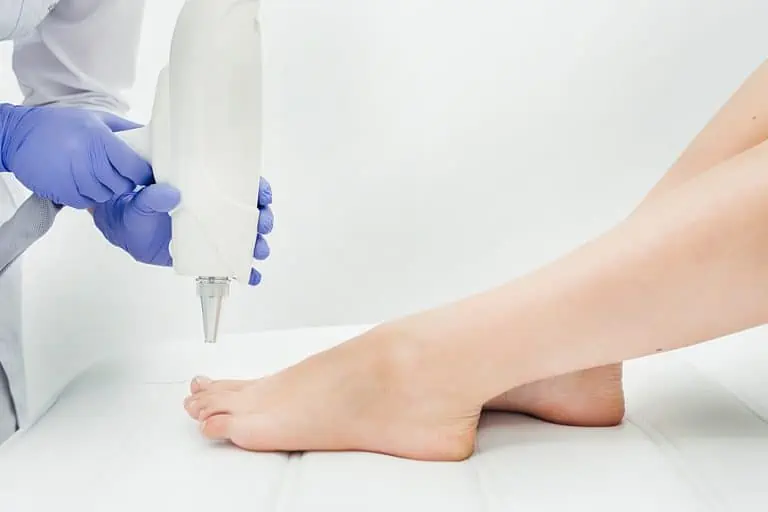The Best Nail Fungus Treatment: What Really Works for Yellow, Crumbly Nails

Nail fungus isn’t pretty. The nails can become misshapen, thick, crumbly and brittle. They may turn a nasty color — yellow, green or brown. Fungal infections of the nail (onychomycosis) can also produce a slightly foul smell. If you’ve developed toenail fungus or fingernail fungus, you’re no doubt searching for the best nail fungus treatment, one that will restore your nails to normal as quickly as possible.
So, how to get rid of nail fungus fast? Unfortunately, it’s not easy. It may take trial and error to find the best nail fungus treatment for you, and no treatment for nail fungus can get rid of it overnight.
There are many over-the-counter nail fungus medicines available, but they may take two months or longer to work, if they work at all — and the nail fungus may return. Topical medicines treat the fungus on the skin surrounding your nail but aren’t as effective at killing fungus in the nail bed.
If you think you have nail fungus, see you dermatologist to make sure. The dermatologist can make an accurate diagnosis and come up with a treatment plan.
Your dermatologist will likely trim the infected nail and scrape away any debris under it, which helps get rid of some of the fungus. The doctor may take a sample of the fungus to identify which type is causing the infection, which helps them decide the best treatment. Your nail fungus treatment plan may include any of the following.
Topical nail fungus medicines
Topical nail fungus medicines are available in several forms, including nail polishes and solutions applied by dropper. Prescription topicals include ciclopirox (Penlac), efinaconazole (Jublia), amorolfine (Curanail and others) and tavaborole (Kerydin). You’ll have to you use them every day or every week for up to a year.
Using topical anti-fungal products alone isn’t always effective, however, because nails are thick and difficult to penetrate. Unless your infection is mild, your dermatologist may suggest you combine a topical medicine with a prescription oral anti-fungal medication.
There are some exceptions. Topicals alone may be prescribed if you have a fungal nail infection caused by a mold, or if you have a less common form of nail fungus called white superficial onychomycosis, which affects only the surface of the nail and causes white spots that eventually become powdery.
Oral anti-fungal medicines
In many cases, you’ll need to take oral anti-fungal medicine prescribed by your dermatologist to get rid of nail fungus completely. Commonly prescribed anti-fungals include itraconazole (Onmel, Sporanox) and terbinafine (Lamisil). These medications are usually taken for at least three to four months.
The downside to oral anti-fungals is the potential for side effects. Side effects may include fever, dry mouth, nausea and diarrhea. Very rarely, liver damage occurs.
Laser treatment for nail fungus
Certain types of laser therapy can tackle stubborn nail fungus by destroying the fungus with heat. One research review showed that laser treatment using a perforated CO2 laser or yttrium-aluminum-garnet (YAG) laser has a moderately high cure rate and strong safety record. Multiple treatments are typically needed. Side effects can include mild to moderate pain and bleeding.
Removing the nail
If other treatments fail, your dermatologist may recommend removing the nail and allowing a healthy nail to grow in its place. Nail removal can be done in the office by applying a chemical that destroys the nail or by removing it surgically. It takes four to six months for a fingernail to regrow and at 12 to 18 months for a toenail to regrow.
Home remedies for nail fungus
Some people try over-the-counter products such as Vicks VapoRub or tea tree oil as home remedies for nail fungus. Vicks VapoRub contains camphor and eucalyptus oil, which may have anti-fungal effects when applied regularly over time. Tea tree oil for nail fungus could in theory help because the oil has anti-fungal properties. But don’t count on either of these for a fast or permanent cure. Seeing a dermatologist is your best bet for treating nail fungus.
Medically reviewed by Andrew Jaffe, MD, FAAD
Written by Jessica Brown, a health and science writer/editor based in Nanuet, New York. She has written for Water’s Edge Dermatology, Prevention magazine, jnj.com, BCRF.org, and many other outlets.


